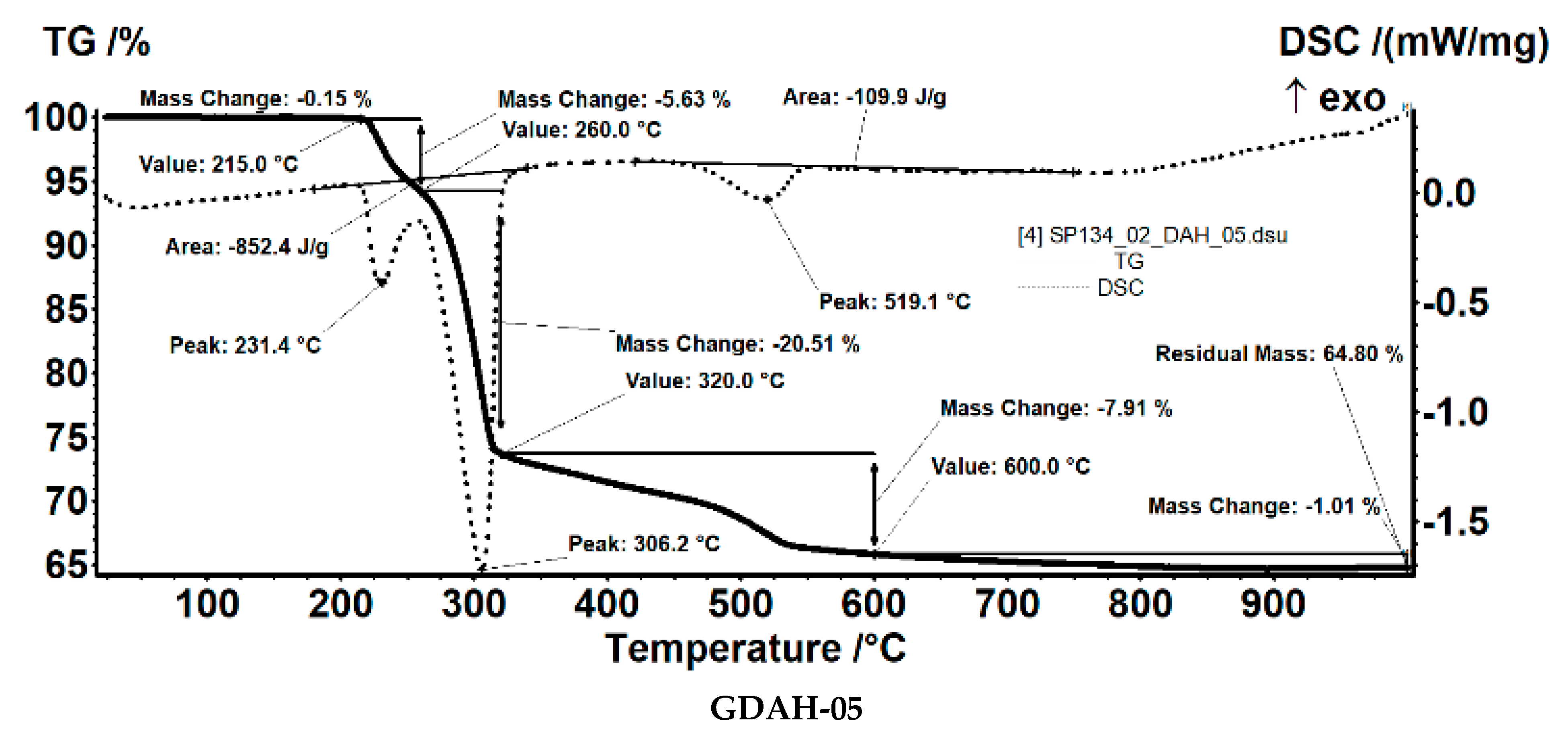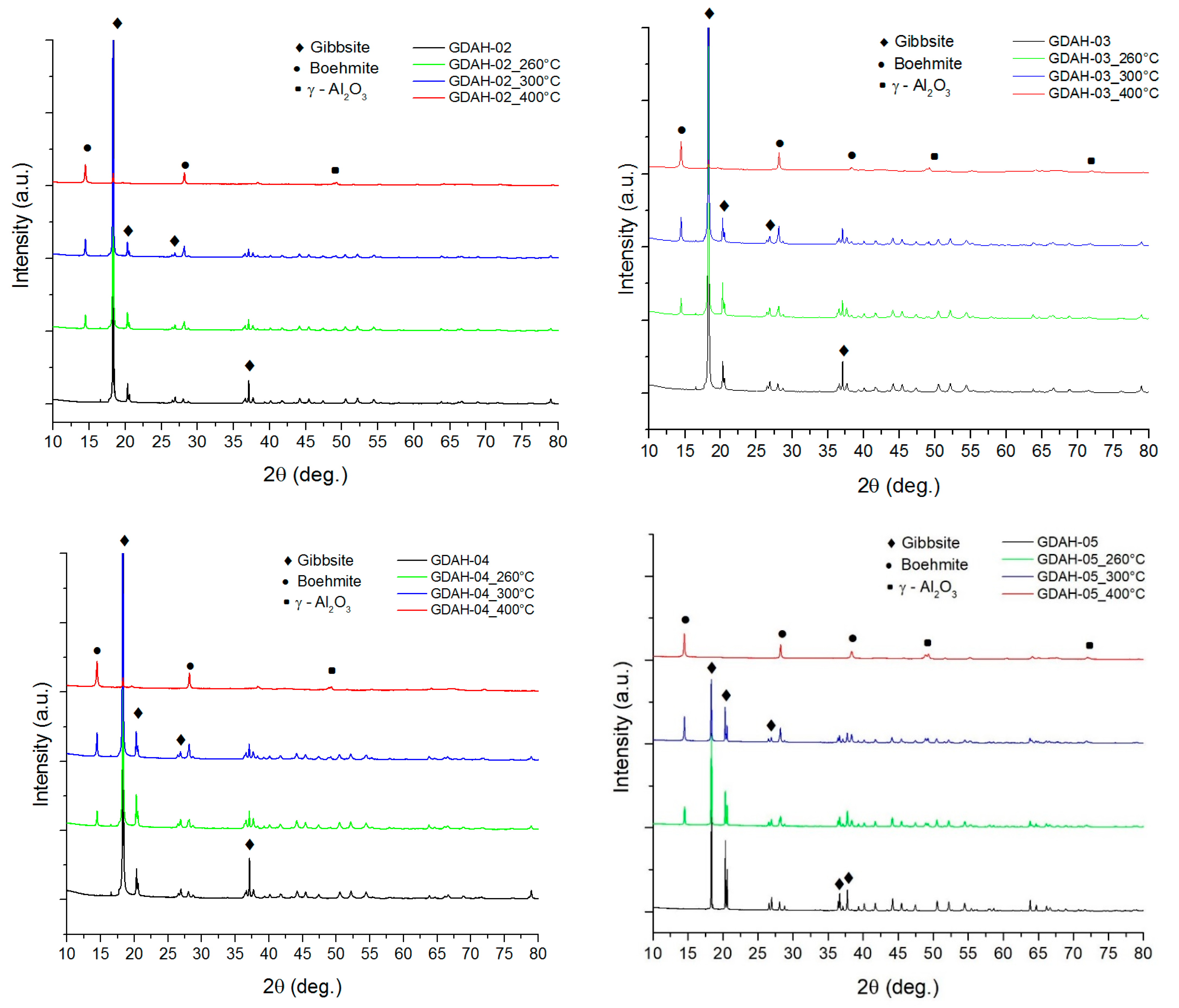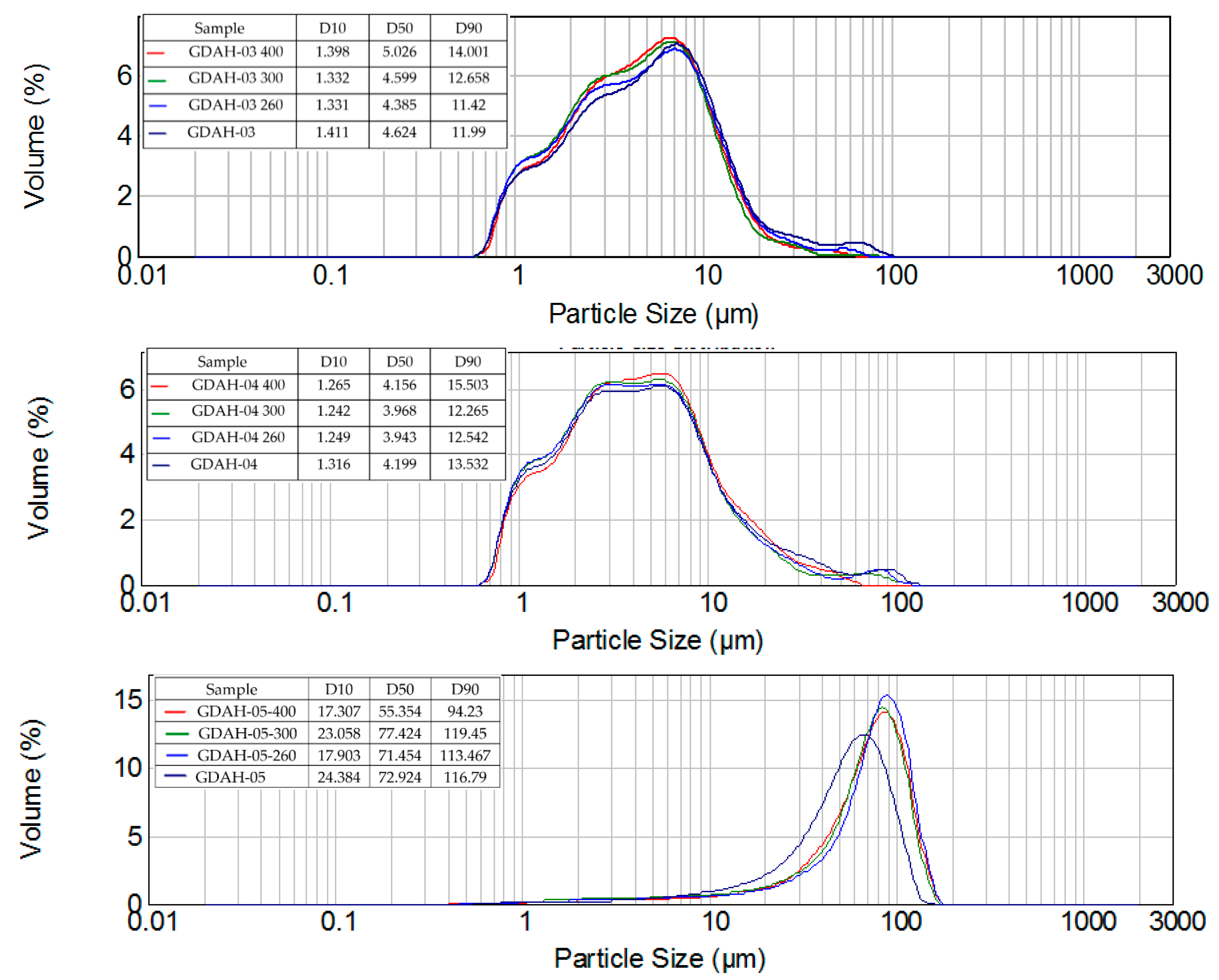Thermally Activated Al(OH)3 Part II—Effect of Different Thermal Treatments
Abstract
:1. Introduction
2. Materials and Methods
2.1. Sample Preparation
2.2. Characterization Methods
3. Results and Discussion
4. Conclusions
Author Contributions
Funding
Institutional Review Board Statement
Informed Consent Statement
Acknowledgments
Conflicts of Interest
References
- Meshcheryakov, E.; Kozlov, M.; Reshetnikov, S.; Isupova, L.; Livanova, A.; Kurzina, I. Studies of water-vapour adsorption dynamics of high-efficiency desiccant based on aluminium oxide and NaX zeolite. Appl. Sci. 2020, 10, 5320. [Google Scholar] [CrossRef]
- Vivekh, P.; Ja, M.K.; Bui, D.; Chua, K. Recent developments in solid desiccant coated heat exchangers—A review. Appl. Energy 2018, 229, 778–803. [Google Scholar] [CrossRef]
- Notorio Ribeiro, J.D.O.; Leite Vasconcelos, D.C.; Vasconcelos, W.L. Importance of the order of addition of the alumina precursor and its type into Al-SBA-15 mesoporous materials for use as water adsorbents. Mater. Res. 2019, 22, e20180651. [Google Scholar]
- Le, T.H.; Nguyen, H.T. The Influence of Alumina Filler on Mechanical, Thermal and Electrical Properties of Bulk Moulding Compounds (BMCs) Composite. Appl. Mech. Mater. 2019, 889, 65–70. [Google Scholar] [CrossRef]
- Saleh, M.; Al-Hajri, Z.; Popelka, A.; Zaidi, S.J. Preparation and characterization of alumina HDPE composites. Materials 2020, 13, 250. [Google Scholar] [CrossRef] [PubMed] [Green Version]
- Chen, P.C.; Yang, L.C. Optimization and Characterization of Nano Aluminum Trihydrate-Based Flame-Retardant Materials in the Rotating Packed Bed Reactor. Mater. Sci. Appl. 2018, 9, 1036–1056. [Google Scholar] [CrossRef] [Green Version]
- Hami, H.K.; Abbas, R.F.; Eltayef, E.M.; Mahdi, N.I. Mahdi Applications of aluminum oxide and nano aluminum oxide as adsorbents: Review. Samarra J. Pure Appl. Sci. 2020, 2, 19–32. [Google Scholar] [CrossRef]
- Kim, J.; Lee, H.; Vo, H.T.; Lee, G.; Kim, N.; Jang, S.; Joo, J.B. Bead-shaped mesoporous alumina adsorbents for adsorption of ammonia. Materials 2020, 13, 1375. [Google Scholar] [CrossRef] [Green Version]
- Szatyłowicz, E.; Skoczko, I. The use of activated alumina and magnetic field for the removal heavy metals from water. J. Ecol. Eng. 2018, 19, 61–67. [Google Scholar] [CrossRef]
- Banerjee, S.; Dubey, S.; Gautam, R.K.; Chattopadhyaya, M.C.; Sharma, Y.C. Adsorption characteristics of alumina nano-particles for the removal of hazardous dye, Orange G from aqueous solutions. Arab. J. Chem. 2019, 12, 5339–5354. [Google Scholar] [CrossRef]
- Norisetty, A.; Basu, J.K.; Sengupta, S. Application of Alumina to Oil and Grease Removal from Refinery Effluent. Hydrol. Curr. Res. 2011, 2, 100011. [Google Scholar] [CrossRef]
- Li, W.; Franco, D.C.; Yang, M.S.; Zhu, X.; Zhang, H.; Shao, Y.; Zhang, H.; Zhu, J. Investigation of the Performance of ATH Powders in Organic Powder Coatings. Coatings 2019, 9, 110. [Google Scholar] [CrossRef] [Green Version]
- Zhang, H.; Yang, B.; Yang, S.; Huang, J.; Cui, J.; Liu, W.; Shan, Y.; Zhang, H.; Zhu, J. Research Status and Development of Functional Powder Coatings, Chemcial Industry and Engineering. Hydrol. Curr. Res. 2020, 37, 1–18. [Google Scholar] [CrossRef]
- Wang, Z.; Shen, X.; Yan, Y.; Qian, T.; Wang, J.; Sun, Q.; Jin, C. Facile fabrication of a PDMS @ stearic acid-Al(OH)3 coating on lignocellulose composite with superhydrophobicity and flame retardancy. Appl. Surf. Sci. 2018, 450, 387–395. [Google Scholar] [CrossRef]
- Souza, A.D.; Arruda, C.C.; Fernandes, L.; Antunes, M.L.; Kiyohara, P.K.; Salomão, R. Characterization of aluminum hy-droxide (Al(OH)3) for use as a porogenic agent in castable ceramics. J. Eur. Ceram. Soc. 2015, 35, 803–812. [Google Scholar] [CrossRef]
- Alexandrovich, I.; Sergeevna, E.; Buyakova, S.; Kulkov, S.N.; Viktorovich, R.; Mamontov, G.; Zhukov, I.A.; Dedova, E.S.; Levkov, R.V. Porous Ceramics Obtained with the Use of Aluminum Hydroxide Powder. Orient. J. Chem. 2016, 32, 93–100. [Google Scholar] [CrossRef]
- Ali, M.S.; MA, A.; Tahir, S.M.; Jaafar, C.N.A.; Norkhairunnisa, M.; Matori, K.A. Preparation and characterization of porous alumina ceramics using different pore agents. J. Ceram. Soc. Jpn. 2017, 125, 402–412. [Google Scholar] [CrossRef] [Green Version]
- Abyzov, A.M. Aluminum Oxide and Alumina Ceramics (review). Part 1. Properties of Al2O3 and Commercial Production of Dispersed Al2O3. Refract. Ind. Ceram. 2019, 60, 24–32. [Google Scholar] [CrossRef]
- Abyzov, A.M. Aluminum Oxide and Alumina Ceramics (Review). Part 2. Foreign Manufacturers of Alumina Ceramics. Technologies and Research in the Field of Alumina Ceramics1. Refract. Ind. Ceram. 2019, 60, 33–42. [Google Scholar] [CrossRef]
- Abyzov, A.M. Oxide and Alumina Ceramics (Review). Part 3. Russian Manufacturers of Alumina Ceramics1. Refract. Ind. Ceram. 2019, 60, 183–191. [Google Scholar] [CrossRef]
- Amin, S.K.; Abdallah, H.A.M.; Roushdy, M.H.; El-Sherbiny, S.A. An overview of production and development of Ceramic Membranes. Int. J. Appl. Eng. Res. 2016, 11, 7708–7721. [Google Scholar]
- Mouratib, R.; Achiou, B.; El Krati, M.; Younssi, S.A.; Tahiri, S. Low-cost ceramic membrane made from alumina and silica-rich water treatment sludge and its application to wastewater filtration. J. Eur. Ceram. Soc. 2020, 40, 594–5950. [Google Scholar] [CrossRef]
- Hakami, M.W.; Alkhudhiri, A.; Al-Batty, S.; Zacharof, M.P.; Maddy, J.; Hilal, N. Ceramic Microfiltration Membranes in Wastewater Treatment: Filtration Behavior, Fouling and Prevention. Membranes 2020, 10, 248. [Google Scholar] [CrossRef] [PubMed]
- Šereš, Z.; Maravić, N.; Takači, A.; Nikolić, I.; Šoronja-Simović, D.; Jokić, A.; Hodur, C. Treatment of vegetable oil refinery wastewater using alumina ceramic membrane: Optimization using response surface methodology. J. Clean. Prod. 2016, 112, 3132–3137. [Google Scholar] [CrossRef]
- Busca, G. Chapter Three—Structural, Surface, and Catalytic Properties of Aluminas, Advances in Catalysis; Academic Press: Cambridge, MA, USA, 2014; Volume 57, pp. 319–404. [Google Scholar]
- Busca, G. Silica-alumina catalytic materials: A critical review. Catal. Today 2019, 357, 621–629. [Google Scholar] [CrossRef]
- Tregubenko, V.Y.; Belyi, A.S. Characterization of Acid-Modified Alumina as a Support for Reforming Catalysts. Kinet. Catal. 2020, 61, 130–136. [Google Scholar] [CrossRef]
- Nikoofar, K.; Shahedi, Y.; Chenarboo, F.J. Nano Alumina Catalytic Applications in Organic Transformations. Mini-Rev. Org. Chem. 2019, 16, 102–110. [Google Scholar] [CrossRef]
- Busca, G. The surface of transitional aluminas: A critical review. Catal. Today 2014, 226, 2–13. [Google Scholar] [CrossRef]
- Wang, L.; Shi, C.; Wang, L.; Pan, L.; Zhang, X.; Zou, J. Rational design, synthesis, adsorption principles and applications of metaloxide adsorbents: A review. Nanoscale 2020, 12, 4790–4815. [Google Scholar] [CrossRef]
- Kovarik, L.; Bowden, M.; Andersen, A.; Jaegers, N.R.; Washton, N.; Szanyi, J. Quantification of High Temperature Transition Al2O3 and Their Phase Transformations. Angew. Chem. 2020, 59, 21719–21727. [Google Scholar] [CrossRef]
- Malki, A.; Mekhalif, Z.; Detriche, S.; Fonder, G.; Boumaza, A.; Djelloul, A. Calcination products of gibbsite studied by X-ray diffraction, XPS and solid-state NMR. J. Solid State Chem. 2014, 215, 8–15. [Google Scholar] [CrossRef]
- Bruschi, L.; Mistura, G.; Nguyen, P.T.M.; Do, D.D.; Nicholson, D.; Park, S.-J.; Lee, W. Adsorption in alumina pores open at one and at both ends. Nanoscale 2014, 7, 2587–2596. [Google Scholar] [CrossRef] [PubMed]
- Vo, H.T.; Kim, J.; Kim, N.Y.; Lee, J.K.; Joo, J.B. Effect of pore texture property of mesoporous alumina on adsorption performance of ammonia gas. J. Ind. Eng. Chem. 2020, 91, 129–138. [Google Scholar] [CrossRef]
- Shirai, T.; Watanabe, H.; Fuji, M.; Takahashi, M. Structural Properties and Surface Characteristics on Aluminum Oxide Powders. Annu. Rep. Ceram. Res. Lab. Nagoya Inst. Technol. 2010, 9, 23–31. [Google Scholar]
- Vieira Coelho, A.C.; Souza Santos, H.D.; Kiyohara, P.K.; Marcos, K.N.P.; Souza Santos, P.D. Surface Area, crystal morphology and characterization of transition alumina powders from a new gibbsite precursor. Mater. Res. 2007, 10, 183–189. [Google Scholar] [CrossRef] [Green Version]
- Egorova, S.R.; Lamberov, A.A. Effect of the phase composition of gibbsite on the specific surface area of coarse Floccule of products formed in its dehydration under thermal treatment. Russ. J. Appl. Chem. 2014, 87, 1021–1030. [Google Scholar] [CrossRef]
- Mehta, S.; Kalsotra, A.; Murat, M. A new approach to phase transformations in gibbsite: The role of the crystallinity. Thermochim. Acta 1992, 205, 191–203. [Google Scholar] [CrossRef]
- Nortier, P.; Fourre, P.; Saad, A.M.; Saur, O.; Lavalley, J.C. Effects of crystallinity and morphology on the surface properties of alumina. Appl. Catal. 1990, 61, 141–160. [Google Scholar] [CrossRef]
- Said, S.; Mikhail, S.; Riad, M. Recent processes for the production of alumina nano-particles. Mater. Sci. Energy Technol. 2020, 3, 344–363. [Google Scholar] [CrossRef]
- Candela, L.; Perlmutter, D.D. Kinetics of boehmite formation by thermal decomposition of gibbsite. Ind. Eng. Chem. Res. 1992, 31, 694–700. [Google Scholar] [CrossRef]
- Kim, H.-I.; Lee, S.K. Probing the transformation paths from aluminum (oxy)hydroxides (boehmite, bayerite, and gibbsite) to metastable alumina: A view from high-resolution 27Al MAS NMR. Am. Miner. 2021, 106, 389–403. [Google Scholar] [CrossRef]
- Kloprogge, T.; Ruan, H.D.; Frost, R.L. Thermal decomposition of bauxite minerals: Infrared emission spectroscopy of gibbsite, boehmite and diaspore. J. Mater. Sci. 2002, 37, 1121–1129. [Google Scholar] [CrossRef] [Green Version]
- Abdelkader, A.; Hussien, B.M.; Fawzy, E.M.; Ibrahim, A.A. Boehmite nanopowder recovered from aluminum cans waste as a potential adsorbent for the treatment of oilfield produced water. Appl. Petrochem. Res. 2021, 11, 137–146. [Google Scholar] [CrossRef]
- Mohammadi, M.; Khodamorady, M.; Tahmasbi, B.; Bahrami, K.; Ghorbani-Choghamarani, A. Boehmite nanoparticles as versatile support for organic–inorganic hybrid materials: Synthesis, functionalization, and applications in eco-friendly catalysis. J. Ind. Eng. Chem. 2021, 97, 1–78. [Google Scholar] [CrossRef]
- Dobra, G.; Iliev, S.; Cotet, L.; Boiangiu, A.; Hulka, I.; Kim, L.; Catrina, G.A.; Filipescu, L. Heavy Metals as Impurities in the Bayer Production Cycle of the Aluminum Hydroxide from Sierra Leone Bauxite. Preliminary Study. J. Sib. Fed. Univ. Eng. Technol. 2021, 151–165. [Google Scholar] [CrossRef]
- Dobra, G.; Garcia-Granda, S.; Iliev, S.; Cotet, L.; Iosif, H.; Negrea, P.; Duteanu, N.; Boiangiu, A.; Filipescu, L. Aluminum Hydroxide Impurities Occlusions and Contamination Sources. Rev. Chim. 2020, 71, 65–76. [Google Scholar] [CrossRef]
- Landek, D.; Ćurković, L.; Gabelica, I.; Kerolli Mustafa, M.; Žmak, I. Optimization of Sintering Process of Alumina Ceramics Using Response Surface Methodology. Sustainability 2021, 13, 6739. [Google Scholar] [CrossRef]
- Mercury, J.R.; Sucupira, J.; Rodríguez, M.A.; Cabral, A.; de Aza, A.H.; Pena, P. Influence of the milling conditions on the thermal decomposition of Bayer gibbsite. Powder Technol. 2020, 362, 188–196. [Google Scholar] [CrossRef]
- Jang, S.-W.; Lee, H.-Y.; Lee, S.-M.; Shim, K.-B.; Lee, S.W. Mechanical activation effect on the transition of gibbsite to α-alumina. J. Mater. Sci. Lett. 2000, 19, 507–510. [Google Scholar] [CrossRef]
- Tsuchida, T.; Ichikawa, N. Mechano-chemical phenomena of gibbsite, bayerite and boehmite by grinding. React. Solids 1989, 7, 207–217. [Google Scholar] [CrossRef]
- Kano, J.; Saeki, S.; Saito, F.; Tanjo, M.; Yamazaki, S. Application of dry grinding to reduction in transformation temperature of aluminum hydroxides. Int. J. Miner. Process. 2000, 60, 91–100. [Google Scholar] [CrossRef]
- Van Gog, H. First-principles study of dehydration interfaces between diaspore and corundum, gibbsite and boehmite, and boehmite and γ-Al2O3: Energetic stability, interface charge effects, and dehydration defects. Appl. Surf. Sci. 2021, 541, 148501. [Google Scholar] [CrossRef]
- Brown, J.F.; Clark, D.; Elliott, W.W. 13. The thermal decomposition of the alumina trihydrate, gibbsite. J. Chem. Soc. 1953, 84–88. [Google Scholar] [CrossRef]
- Yamaguchi, G.; Sakamoto, K. Hydrothermal Reaction of Aluminumtrihydroxides. Bull. Chem. Soc. Jpn. 1959, 32, 696–699. [Google Scholar] [CrossRef]
- Day, M.K.B.; Hill, V.J. Thermal Transformations of the Aluminas and their Hydrates. Nature 1952, 170, 539. [Google Scholar] [CrossRef]
- Sato, T. Hydrothermal reaction of alumina trihydrate. J. Appl. Chem. 2007, 10, 414–417. [Google Scholar] [CrossRef]
- Rouquerol, J.; Rouquerol, F.; Ganteaume, M. Thermal decomposition of gibbsite under low pressures. I. Formation of the boehmitic phase. J. Catal. 1975, 36, 99–110. [Google Scholar] [CrossRef]
- Filho, R.W.N.D.; Rocha, G.D.A.; Montes, C.R.; Vieira-Coelho, A.C. Synthesis and Characterization of Boehmites Obtained from Gibbsite in Presence of Different Environments. Mater. Res. 2016, 19, 659–668. [Google Scholar] [CrossRef] [Green Version]
- Woo, S.; Park, J.-H.; Rhee, C.K.; Lee, J.; Kim, H. Effect of thermal treatment on the aluminum hydroxide nanofibers synthesized by electrolysis of Al plates. Microelectron. Eng. 2012, 89, 89–91. [Google Scholar] [CrossRef]
- Authier-Martin, M.; Forté, G.; Ostap, S.; See, J. The mineralogy of bauxite for producing smelter-grade alumina. JOM 2001, 53, 36–40. [Google Scholar] [CrossRef]
- Matters, S. Reactions of lime under high temperature Bayer digestion conditions. In 10th International Alumina Quality Workshop; AQW Incorporated: Walton, KY, USA, 2015; p. 373. [Google Scholar]
- Baranyai, V.Z.; Kristály, F.; Szűcs, I. Influence of grain and crystallite size on the gibbsite to boehmite thermal transfor-mation. Studia UBB Chem. 2015, 60, 27–44. [Google Scholar]
- Lopushan, V.I.; Kuznetsov, G.F.; Pletnev, R.N.; Kleshev, D.G. Kinetics of phase transitions of gibbsite during heat treatment in air and in water vapor. Refract. Ind. Ceram. 2007, 48, 378–382. [Google Scholar] [CrossRef]
- Wang, Q.; Li, Y.; Li, S.; Chen, R.; Xiang, R.; Xu, N. Effects of particle size of Al(OH)3 on the properties of porous purging materials. J. Ceram. Soc. Jpn. 2017, 125, 504–508. [Google Scholar] [CrossRef] [Green Version]
- Gan, B.K.; Madsenb, I.C.; Hockridge, J.G. In situ X-ray diffraction of the transformation of gibbsite to a-alumina through calci-nation: Effect of particle size and heating rate. J. Appl. Cryst. 2009, 42, 697–705. [Google Scholar] [CrossRef]
- Danilevich, V.V.; Klimov, O.; Nadeina, K.A.; Gerasimov, E.Y.; Cherepanova, S.V.; Vatutina, Y.V.; Noskov, A.S. Novel eco-friendly method for preparation of mesoporous alumina from the product of rapid thermal treatment of gibbsite. Superlattices Microstruct. 2018, 120, 148–160. [Google Scholar] [CrossRef]
- Ibrahim, I.; Baharuddin, S.; Arbain, R.; Othman, A.; Joannes, C. Processing of local bauxite to obtain highly purified and fine alumina powder. In International Conference of Sustainable Earth Resources Engineering 2020 IOP Conference Series: Earth and Environmental Science 641; IOP Publishing: Bristol, UK, 2021. [Google Scholar] [CrossRef]
- Redaoui, D.; Sahnoune, F.; Heraiz, M.; Raghdi, A. Mechanism and Kinetic Parameters of the Thermal Decomposition of Gibbsite Al(OH)3 by Thermogravimetric Analysis. Acta Phys. Pol. A 2017, 131, 562–565. [Google Scholar] [CrossRef]
- Gralik, G.; Chinelattot, A.L.; Chinelatto, A. Effect of different sources of alumina on the microstructure and mechanical properties of the triaxial porcelain. Cerâmica 2014, 60, 471–481. [Google Scholar] [CrossRef]
- Vahidi, G.; Bajwa, D.S.; Shojaeiarani, J.; Stark, N.; Darabi, A. Advancements in traditional and nanosized flame retardants for polymers—A review. J. Appl. Polym. Sci. 2020, 138. [Google Scholar] [CrossRef]
- Padilla, I.; López-Andrés, S.; López-Delgado, A. Effects of Different Raw Materials in the Synthesis of Boehmite and γ- and α-Alumina. J. Chem. 2016, 2016, 5353490. [Google Scholar] [CrossRef] [Green Version]





| Sample Code | Dimensions after Milling | Calcination Temperature (°C) |
|---|---|---|
| GDAH-02 | <45 µm = 98.29% | - |
| GDAH-02-260 | <45 µm = 98.29% | 260 |
| GDAH-02-300 | <45 µm = 98.29% | 300 |
| GDAH-02-400 | <45 µm = 98.29% | 400 |
| GDAH-03 | <20 µm = 92.13% | - |
| GDAH-03-260 | <20 µm = 92.13% | 260 |
| GDAH-03-300 | <20 µm = 92.13% | 300 |
| GDAH-03-400 | <20 µm = 92.13% | 400 |
| GDAH-04 | <10 µm = 76.28% | - |
| GDAH-04-260 | <10 µm = 76.28% | 260 |
| GDAH-04-300 | <10 µm = 76.28% | 300 |
| GDAH-04-400 | <10 µm = 76.28% | 400 |
| GDAH-05 | <45 µm = 0.001%; >150 µm = 6.54% | - |
| GDAH-05-260 | <45 µm = 0.001%; >150 µm = 6.54% | 260 |
| GDAH-05-300 | <45 µm = 0.001%; >150 µm = 6.54% | 300 |
| GDAH-05-400 | <45 µm = 0.001%; >150 µm = 6.54% | 400 |
| Sample | Mineral Name | Amorphous Phases (%) | ||
|---|---|---|---|---|
| Gibbsite (%) | Boehmite (%) | γ-Al2O3 (%) | ||
| GDAH-02 | 62.54 | 0.00 | 0.00 | 37.46 |
| GDAH-02-260 | 46.42 | 4.15 | 0.00 | 49.43 |
| GDAH-02-300 | 34.60 | 5.82 | 0.57 | 59.00 |
| GDAH-02-400 | 3.32 | 7.45 | 10.61 | 78.60 |
| GDAH-03 | 61.67 | 0.00 | 0.00 | 38.33 |
| GDAH-03-260 | 45.41 | 2.80 | 0.00 | 51.79 |
| GDAH-03-300 | 38.33 | 4.99 | 0.44 | 56.25 |
| GDAH-03-400 | 0.05 | 5.44 | 12.81 | 81.70 |
| GDAH-04 | 62.59 | 0.00 | 0.00 | 37.41 |
| GDAH-04-260 | 53.23 | 2.62 | 0.00 | 44.15 |
| GDAH-04-300 | 43.26 | 5.48 | 0.64 | 50.62 |
| GDAH-04-400 | 2.28 | 6.86 | 12.98 | 77.88 |
| GDAH | 55.56 | 0.00 | 0.00 | 44.44 |
| GDAH-05-260 | 43.48 | 8.28 | 0.00 | 48.24 |
| GDAH-05-300 | 33.81 | 11.94 | 0.00 | 54.25 |
| GDAH-05-400 | 0.05 | 12.86 | 13.79 | 73.32 |
Publisher’s Note: MDPI stays neutral with regard to jurisdictional claims in published maps and institutional affiliations. |
© 2021 by the authors. Licensee MDPI, Basel, Switzerland. This article is an open access article distributed under the terms and conditions of the Creative Commons Attribution (CC BY) license (https://creativecommons.org/licenses/by/4.0/).
Share and Cite
Vasile, B.S.; Dobra, G.; Iliev, S.; Cotet, L.; Neacsu, I.A.; Surdu, V.A.; Nicoara, A.I.; Boiangiu, A.; Filipescu, L. Thermally Activated Al(OH)3 Part II—Effect of Different Thermal Treatments. Ceramics 2021, 4, 564-575. https://doi.org/10.3390/ceramics4040040
Vasile BS, Dobra G, Iliev S, Cotet L, Neacsu IA, Surdu VA, Nicoara AI, Boiangiu A, Filipescu L. Thermally Activated Al(OH)3 Part II—Effect of Different Thermal Treatments. Ceramics. 2021; 4(4):564-575. https://doi.org/10.3390/ceramics4040040
Chicago/Turabian StyleVasile, Bogdan Stefan, Gheorghe Dobra, Sorin Iliev, Lucian Cotet, Ionela Andreea Neacsu, Vasile Adrian Surdu, Adrian Ionut Nicoara, Alina Boiangiu, and Laurențiu Filipescu. 2021. "Thermally Activated Al(OH)3 Part II—Effect of Different Thermal Treatments" Ceramics 4, no. 4: 564-575. https://doi.org/10.3390/ceramics4040040








